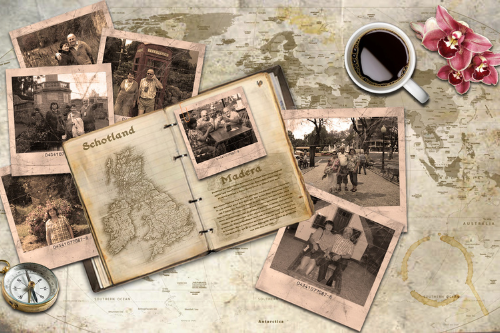Mastering the Interpretation and Verification of Evidence
Understanding Ancestry Evidence
Ancestry evidence serves as the foundation of genealogical research, offering vital clues about our familial lineage and history. These pieces of evidence come in various forms, each providing unique insights into the lives of our ancestors. Birth records, for example, not only confirm the existence of individuals but also provide valuable details such as parents' names, birthplaces, and dates, essential for tracing family lines and establishing connections. Similarly, death records offer insights into the end of an individual's life, often providing information on family relationships, causes of death, and burial locations, which can further illuminate familial ties and migration patterns.
Other types of ancestry evidence, such as census records, immigration documents, and historical narratives, contribute additional layers to the ancestral narrative. Census records offer snapshots of individuals and families at specific points in time, providing demographic information, household compositions, and sometimes even occupations. Immigration documents shed light on ancestral journeys, documenting arrivals, departures, and naturalization processes, offering glimpses into the challenges and triumphs of migration. Historical narratives, whether oral histories passed down through generations or written accounts of significant events, provide context to ancestral lives, painting a richer picture of their experiences, beliefs, and cultural heritage.
How to Interpret Your Ancestry Evidence
Interpreting ancestry evidence requires a combination of analytical skills, historical knowledge, and attention to detail. Begin by thoroughly examining each document, paying close attention to dates, names, and locations. Compare information across multiple sources to identify inconsistencies or discrepancies that may require further investigation. For instance, differences in birth dates between census records and birth certificates could indicate errors or intentional misreporting, highlighting the importance of corroborating evidence.
Case examples can illustrate common interpretive challenges encountered in genealogical research. For instance, deciphering handwritten records can pose difficulties due to varying handwriting styles and faded ink, requiring patience and careful analysis. Similarly, navigating naming conventions across cultures and time periods can be complex, with individuals often referred to by different names or spellings throughout their lives. By familiarizing themselves with common challenges and techniques for overcoming them, amateur family historians can enhance their ability to accurately interpret ancestry evidence and uncover hidden connections within their family trees.
To follow are a couple case studies to help exemplify these common challenges.
Case Study 1: Handwritten Records
Imagine you're researching the family history of your great-grandmother, Elizabeth Brown. You come across a handwritten census record from 1900 that lists her name as "Eliza Brown" instead of "Elizabeth Brown." Additionally, her age is recorded as 25, which conflicts with her known birth year of 1875. Furthermore, the handwriting is difficult to decipher, with faded ink and stylistic variations that make it challenging to discern certain details.
In this case, the interpretive challenge lies in deciphering the handwritten record and reconciling the discrepancies in the information provided. You must carefully analyze the handwriting, taking into account variations in spelling and stylistic conventions of the time period. Consulting additional sources, such as birth records or marriage certificates, can help confirm Elizabeth's correct name and age, shedding light on potential errors or inconsistencies in the census record.
By familiarizing yourself with common challenges in interpreting handwritten records and employing techniques such as magnification, comparison with known examples of handwriting from the same time period, and collaboration with experienced researchers, you can overcome these obstacles and uncover accurate information about your ancestor's life.
Case Study 2: Naming Conventions
Consider another scenario where you're researching the family history of your paternal ancestors, the Smith family. While tracing your lineage back several generations, you encounter variations in the spelling of surnames and given names, as well as instances where individuals are referred to by different names or nicknames.
For example, your great-great-grandfather, John Smith, is listed as "Jonathan Smith" in one census record and "Jack Smith" in another. Similarly, his wife, Mary, is recorded as "Molly" in some documents and "Polly" in others. These variations in naming conventions can be attributed to factors such as regional dialects, cultural influences, and personal preferences.
In this case, the interpretive challenge lies in navigating the complexities of naming conventions across different cultures and time periods. You must carefully analyze each piece of evidence, considering the context in which it was created and the potential reasons for variations in names. Consulting historical records, family narratives, and local customs can provide valuable insights into the naming practices of your ancestors, helping you unravel the mystery of their identities and relationships.
By familiarizing yourself with common naming conventions and employing techniques such as cross-referencing multiple sources, collaborating with other researchers, and remaining open to alternative interpretations, you can overcome these challenges and gain a deeper understanding of your family's history.
Standards of Proof in Genealogy
Genealogical research adheres to standards of proof to ensure the reliability and credibility of conclusions drawn from evidence. These standards, such as the Genealogical Proof Standard (GPS), provide guidelines for conducting thorough research, analyzing evidence, and reaching well-supported conclusions. The GPS consists of five components: reasonably exhaustive research, complete and accurate citations, analysis and correlation of evidence, resolution of conflicting evidence, and a soundly reasoned, coherently written conclusion.
By adhering to these standards of proof, genealogists can systematically evaluate the quality of evidence and the strength of their conclusions, distinguishing between well-supported assertions and speculative assumptions. This rigorous approach promotes transparency, accuracy, and accountability within the genealogical community, fostering a culture of trust and collaboration. Ultimately, by upholding standards of proof in their research practices, amateur family historians can contribute to the advancement of genealogical knowledge and the preservation of ancestral heritage for future generations.
To recall, I have included the standards of proof below.
Reasonably Exhaustive Research: Genealogical research should involve a thorough examination of all available sources relevant to the research question or problem. This includes primary sources, secondary sources, and derivative sources, as well as negative evidence (evidence that suggests the absence of a particular fact). By conducting comprehensive research, genealogists can ensure that they have considered all possible avenues of inquiry and have gathered sufficient evidence to support their conclusions.
Complete and Accurate Citations: Proper citation of sources is essential for genealogical research, as it allows others to verify and replicate the research findings. Citations should include detailed information about the source, such as the title, author, publication date, repository location, and page number. Genealogists should strive to provide complete and accurate citations for all sources consulted, both in their research notes and in any publications or presentations.
Analysis and Correlation of Evidence: Genealogical research involves analyzing and correlating evidence from multiple sources to build a coherent and accurate narrative of family relationships and events. This requires careful examination of each piece of evidence, consideration of its reliability and relevance, and comparison with other available evidence. Genealogists should look for patterns, inconsistencies, and gaps in the evidence, and use logic and critical thinking to draw logical conclusions.
Resolution of Conflicting Evidence: Conflicting evidence is common in genealogical research and must be carefully addressed to ensure accurate conclusions. Genealogists should evaluate conflicting evidence objectively, consider alternative explanations or interpretations, and seek additional sources or information to resolve discrepancies. This may involve consulting with other researchers, conducting further research, or reevaluating existing evidence in light of new information.
Soundly Reasoned, Coherently Written Conclusion: Genealogical research should culminate in a well-reasoned and coherent conclusion that is supported by the available evidence. This conclusion should be based on a thorough analysis of the evidence, adherence to the standards of proof outlined in the GPS, and clear reasoning and logic. Genealogists should strive to present their findings in a clear and organized manner, using proper grammar, syntax, and citation formatting to communicate their research effectively to others.
Verifying Your Ancestry Records
Verifying ancestry records involves a systematic process of cross-checking and authenticating information to ensure its accuracy and reliability. Begin by verifying primary sources, such as original birth certificates, marriage licenses, and probate records, which offer firsthand documentation of key life events. Scrutinize secondary sources, such as published family histories or online genealogical databases, for biases, errors, or inconsistencies that may affect their reliability.
In cases of conflicting evidence, conduct further research to reconcile discrepancies and establish the most accurate interpretation. Consult additional sources, seek guidance from experienced genealogists or historians, and consider alternative explanations for inconsistencies. Embrace technology as a tool for verification, utilizing online databases, DNA testing, and digital preservation techniques to augment traditional research methods and uncover new insights into ancestral connections.
Best practices for record compilation and storage ensure the integrity and accessibility of genealogical data for future generations. Maintain organized records, complete with detailed citations and source information, to facilitate replication and verification by others. Backup digital records regularly and store physical documents in archival-quality materials to protect them from damage or deterioration over time. By adopting a proactive approach to record verification and preservation, amateur family historians can safeguard their research efforts and contribute to the long-term preservation of ancestral heritage.
These examples demonstrate the importance of systematic verification and preservation techniques in genealogical research, ensuring the accuracy, reliability, and accessibility of ancestral records for generations to come.
Example 1:
Imagine you're researching the marriage of your great-grandparents, John Smith and Mary Johnson. You've obtained a marriage certificate from a local courthouse, which serves as a primary source of information. The certificate lists their names, the date and location of the marriage, and the names of witnesses. To verify this information, you cross-reference the marriage certificate with other primary sources, such as church records or newspaper announcements, to confirm the accuracy of the details provided.
However, while conducting your research, you come across conflicting evidence in the form of a published family history that suggests John Smith married a different woman named Margaret Jones. To reconcile this inconsistency, you delve deeper into both lines of inquiry, seeking additional primary sources and consulting with experienced genealogists or historians for guidance. Through careful analysis and consideration of alternative explanations, you discover that there were indeed two individuals named John Smith living in the same area during that time period, leading to the confusion in the family history.
To further authenticate your findings, you turn to technology as a tool for verification, utilizing online databases and digital preservation techniques to access additional records and uncover new insights. By combining traditional research methods with modern technology, you're able to establish the most accurate interpretation of your ancestors' marital history and ensure the integrity of your genealogical research.
Example 2:
Suppose you've inherited a collection of family photographs and documents from your grandparents, including handwritten letters, land deeds, and immigration records. While these materials offer valuable insights into your family's past, they also present challenges in terms of organization and preservation. To maintain the integrity and accessibility of this genealogical data for future generations, you implement best practices for record compilation and storage.
You begin by carefully cataloging each item, assigning unique identifiers and detailed descriptions to facilitate replication and verification by others. You create digital backups of photographs and documents, storing them in secure, cloud-based storage platforms to protect against loss or damage. For physical documents, such as handwritten letters or land deeds, you invest in archival-quality materials, such as acid-free folders and storage boxes, to prevent deterioration over time.
As you compile and organize your family records, you also take care to document the sources of information, providing complete citations and source information for each item. This not only enhances the credibility of your research but also enables others to verify and build upon your findings. By adopting a proactive approach to record verification and preservation, you're able to safeguard your research efforts and contribute to the long-term preservation of your ancestral heritage for future generations to cherish and explore.
Conclusion
In conclusion, interpreting and verifying ancestry evidence is a multifaceted process that requires diligence, critical thinking, and adherence to established standards of proof. By mastering these skills and techniques, amateur family historians can unlock the rich tapestry of their ancestral heritage with confidence and accuracy. Embrace the journey of discovery, celebrating both the triumphs and challenges encountered along the way. By taking these processes seriously and committing to ongoing learning and improvement, amateur family historians can enrich their genealogical research journey and leave a lasting legacy for future generations to cherish and build upon.


Article by Carol Walsh
Carol Walsh is the CEO of Creative Roots, a professional genealogy company. She has a passion for preserving family history and storytelling. Carol's research methodology centers around fact-finding and publishing in a format that readers can use to preserve the stories. Her ultimate goal is to help families connect with their past and each other.





